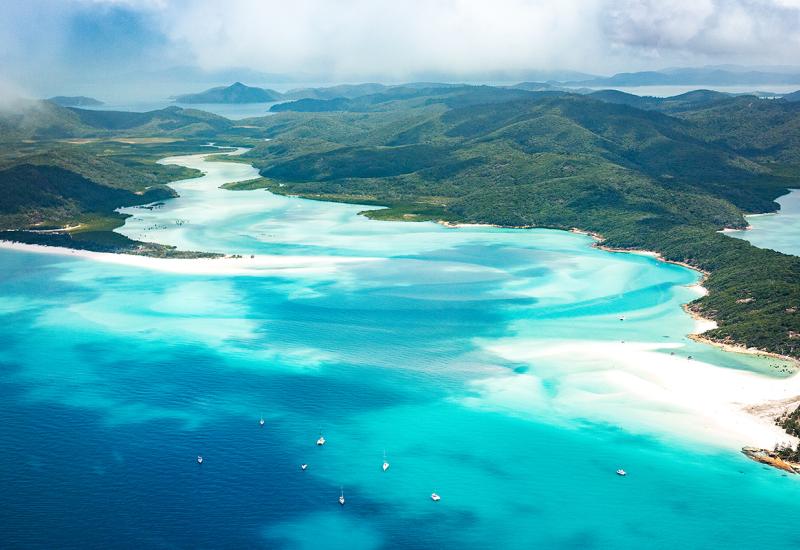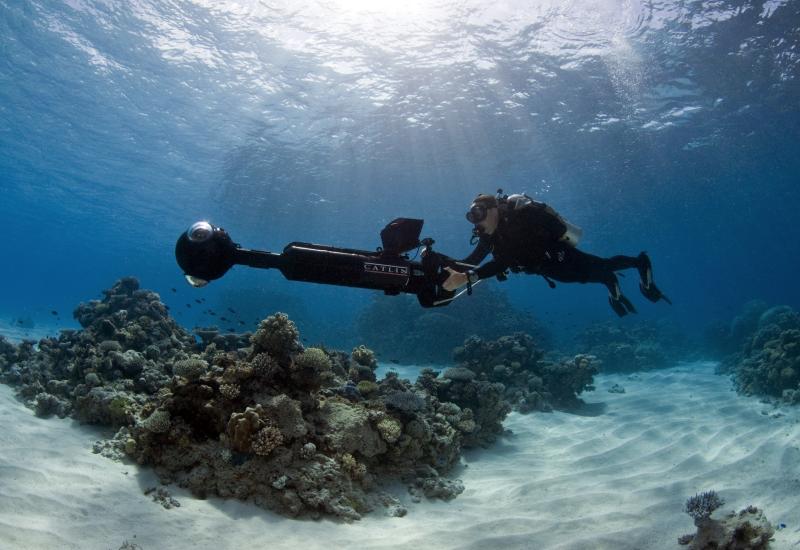Unexpected Vanuatu
As if Viti Levu weren't far enough away or pristine enough. As if we needed to fly two more hours. And for what? Another wreck dive? Is there really a place on earth worth it? Vanuatu is worth it. Remote places like Papua New Guinea and the Solomon Islands are spread to the north. Australia is 1,600 miles and a world away to the southwest. Could these 83 volcanic islands isolated in the South Pacific be worth it? Vanuatu is worth it. Why? Because you could spend your entire vacation diving the SS President Coolidge, the largest accessible wreck anywhere in the world. Or because you could spend it diving freshwater blue holes or a mostly uncharted cave system. Or because 3,500 years of Pacific culture makes topside diversions as worthwhile as the diving. As we discovered, Vanuatu is worth it.Capital DivingOur diving adventure began in Port Vila, the capital of this island nation that gained independence in 1980. Located on Efate Island in the middle of a Y-shaped archipelago, Port Vila is a bustling, modern city with clean streets and scenic ocean vistas; a western tourist's dream that seamlessly blends 21st-century commerce with rustic island charm. On arrival, we settled into Le Meridien Resort, a luxury resort known for its over-the-water bungalows. Our first order of business was a swim in the lagoon and a gourmet poolside lunch. With temperatures in the low 70s in the winter and mid 80s in the summer, most of life in Vanuatu is done al fresco. The rest of the day we spent immersing ourselves in this island nation's potpourri of Melanesian culture, followed by another swim in the Cascades, a series of waterfalls and pools nestled in a rain forest just outside of town. Vanuatu's 200,000 people are said to have 115 mother tongues, but English, French and Bislama (a simplified form of phonetic English, with Spanish, French and colloquialisms added for good measure) are its primary languages. Although the first western explorers landed here in 1605, modern Vanuatu has been most influenced by 40 years of post-World War II British and French occupation. Our first day of diving dawned clear and hot. We were eager to see if Vanuatu underwater rivaled what we had seen topside. Warwick Davidson of Nautilus Scuba welcomed us aboard a large catamaran, and we were soon cruising Mele Lagoon. Mele Reef, in the middle of the bay, provided a vertical wall starting at 20 feet that dropped deeper than we dared to venture. Small reef fish floated in clouds around the wall, drifting in and out of the hard coral web. Crinoids, gorgonians and anthias gorged themselves on plankton in the nutrient-thick water. Taking a cue from the reef inhabitants, we spent our surface interval refueling with some local delicacies before rolling into Blacksands Reef and Caves. This reef sports swim-through honeycomb tunnels, home to numerous species of invertebrates and fish. Beginning at 25 feet, the reef gracefully dips down to a white, sandy bottom at 70 feet. The current runs through the tunnels like a soft breeze carrying nutrients into the waiting arms of the corals. We played underwater hide and seek with the local reef inhabitants until it was time to return to our own environment. Spoils of WarAfter four days touring Efate, an 18-passenger twin-otter plane carried us to Espiritu Santo, the oldest and largest island of the Vanuatu archipelago. From the town of Luganville, we were shuttled to the tropical gardens of Bougainville Hotel. With circular bungalows, a pool and an open-air dining area that mixed white-linen luxury with casual island dining, Bougainville was a pleasant respite from the wildness of the island. From the moment we arrived, Yvan and Elaine Charles, the proprietors of this quaint family-owned hideaway, regaled us with quips and stories of Vanuatu's history and folklore. The next morning, we were whisked away by Kevin Green, owner of Aquamarine, to our first dive at Million Dollar Point. Unlike many other dive sites named for their formations or marine life, Million Dollar Point has a story all its own. At the end of WWII, the American military offered its used military and construction equipment to the British at 10 cents on the dollar. Assuming the equipment would simply be left behind, the British refused, hoping to get it for free. While attending a luncheon hosted by the Americans, the British watched in horror as U.S. troops dumped thousands of tons of equipment into the ocean. Each piece of machinery is now home to various ocean creatures. We dedicated the next five days to diving the SS President Coolidge, a first-class luxury liner that was pressed into service as a U.S. troop transport ship in 1941. On her first trip to Vanuatu, she hit a friendly harbor mine and was completely submersed within an hour. Today, the bow of the 654-foot ship rests at 55 feet, her stern at 220 feet.To help divers access the Coolidge, Aquamarine offers all levels of guided dives (from basic sport diving to double tank and mixed gas) with a monitored, extra-air deco stop for all divers. To add a safety margin, Santo now has its own fully staffed hyperbaric recompression chamber. One of the favorite Coolidge dives is The Lady. At 145 feet, inside the superstructure to what was the smoking room, a porcelain statue of an Elizabethan lady and her horse adorns the fireplace mantle. Lying on its port side and with little natural light penetrating the dark water required some creative photography to capture her on film. Lit with four slave strobes (two hidden behind the fireplace with TTL sensors attached) we finally got the wide-angle effect we were hoping for. After a quick kiss for good luck, we left The Lady in her watery grave and proceeded to the decompression area. The Deco Stop is a great dive in its own right thanks to an artificial reef. Allan Power, one of the original Coolidge explorers, created the reef that is now home to Boris, a 400-pound grouper and his entourage of trevally. Other inhabitants included a large, colorful mantis shrimp, a pair of fire gobies, clownfish (that were aerating their eggs), free-swimming lionfish and a blind Ampheus shrimp living symbiotically with a blue-speckled shrimp goby.The Blue HoleSaturated with the Coolidge, we asked if there was other unique Santo diving. A 40-minute drive through cow pasture and coconut plantations brought us to a pool of striking blue. Jackie's Blue Hole is 100 feet wide and 40 feet deep with meandering channels that drift to the sea. Covered with thick grass mats, the channels varied in depth from two-foot passages to deep bowls. A refreshingly cool 75 degrees, the crystal fresh water remained clear as long as the algae strewn bottom was not stirred up. Rays of sun streaming through the grass mats reflected off limestone formations created a prism of colors. Mesmerized, we made as many dives as our computers and the chilly water allowed. Over homemade ice cream, Green described an intricate underwater cave system recently discovered on Espiritu Santo, and how Aquamarine was in the process of exploring and mapping it (see side bar). We did not experience Santo's acclaimed cave system since we were not cave-diving certified. Lava and the DugongAfter 10 solid days of diverse world-class diving, we flew three hours south to our last island stop in the Vanuatu archipelago, Tanna. In 1774, Captain Cook landed on this small island in what he had called New Hebrides. He tapped the ground asking the villagers what they called the island. They responded with the native word for earth, Tanna. Forever mislabeled by this new-world explorer, Tanna's true name, Napikinuma, comes from the island's fishtail shape. A rustic island populated with friendly Melanesian villagers, Tanna is home to two rarely accessible natural wonders. The most noted is the active volcano, Yasur. Spewing lava, ash and continuous steam, it is an awesome if not frightening site. We had hiked to the rim before our guide casually told us that two tourists had recently been killed by wayward lava. Tanna's other unique attraction is a full-grown wild dugong that resides in the small bay at the base of Yasur volcano. Dugongs are similar to Florida manatees, except that they have a whale-shaped tail instead of a paddle-shaped tail. Quite incredibly the local villagers at Port Resolution Yacht Club have developed a relationship with the lone male after its mate was killed. Whether out of loneliness or to protect his territory from intruders, the dugong responds to the villagers slapping the water. After we entered the water, the 10-foot male swam right up, examining and touching us and allowing us to touch him. The dugong's behavior ranged from curious and docile to aggravated and aggressive. Spying his reflection in the dome port of my husband's camera housing, the dugong launched headfirst into his chest, sending the camera to the sand. Recognizing the animal's confusion, we watched him closely. Keeping a respectable distance, we allowed him to control the encounter. Three hours later, our film and strength exhausted, we watched the wondrous creature take one last look at us and swim back to the open ocean. It was just one more cherished memory we will keep from our very worthwhile trip to Vanuatu. Espiritu Santo - Cave Diving's Next FrontierThe Sarakata is the main river that runs through the town of Luganville on Espiritu Santo. Kevin and Mayumi Green have traced the river to its source, a natural underground spring that opens into a world class underwater cave system. Along with professional cave divers from Australia, they have mounted three expeditions to explore and map this virgin intricate system. To date, the explorers have reached 5,525 feet, five and a half hours inside. The cave system has dipped to a maximum depth of 100 feet, and so far two air caves have been discovered. Although the cave system is far too vast for the average cave diver, the first 1,500 feet affords spectacular views and is generally accessible. This is only one of the many caves Santo has to offer. The other caves vary from 60 to 5,100 feet swims, with depths from 45 to 175 feet. Visibility varies depending on the rainfall and can be anywhere from 15 - 180 feet. The current, slow and easy, flows down to the sea carrying diver silting with it. Therefore, most dives are started up current. All Santo cave formations are limestone based. They have small, tight restrictions and also large rooms. Divers intending to dive the caves are required to have relevant cave diving qualifications. Most are accessible by four-wheel-drive trucks and are located approximately 45 minutes from Luganville. Some require a hike (over an hour) through farm land and jungle with local native sherpers used to carry the dive gear. All caves in the area (so far discovered) have been mapped and have fixed guidelines installed. For an additional margin of safety, Espiritu Santo has a fully staffed Hyperbaric recompression chamber available. All cave-diving operations are run by Aquamarine Ltd. They offer all levels of scuba instruction including instructor courses and a full list of technical courses. They provide mixed gas diving, including Nitrox and Trimix. Aquamarine is located on the water and has full washing facilities, lock-up drying rooms and a large area for guest entertainment where the ''Aussie'' jokes are swapped with reckless abandon. For more information about touring and diving Vanuatu, click onto the Island Dreams home page below.










